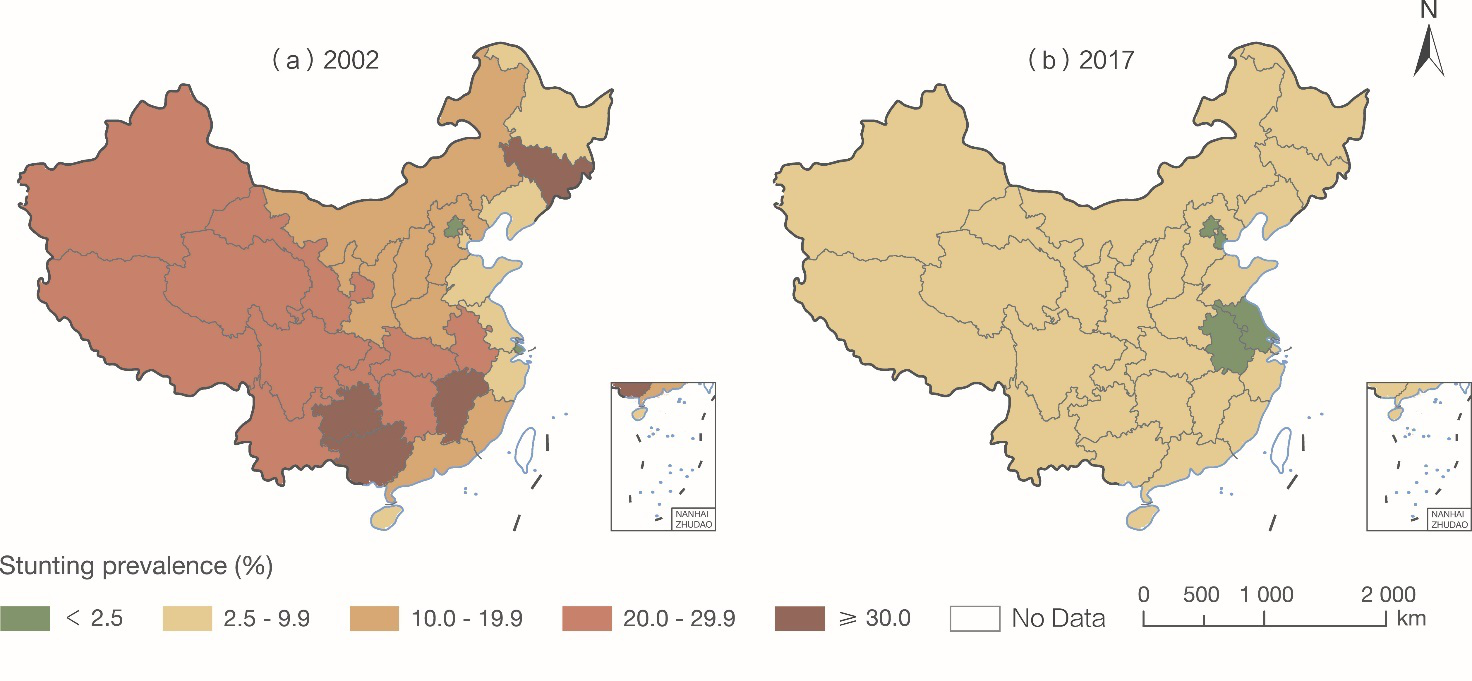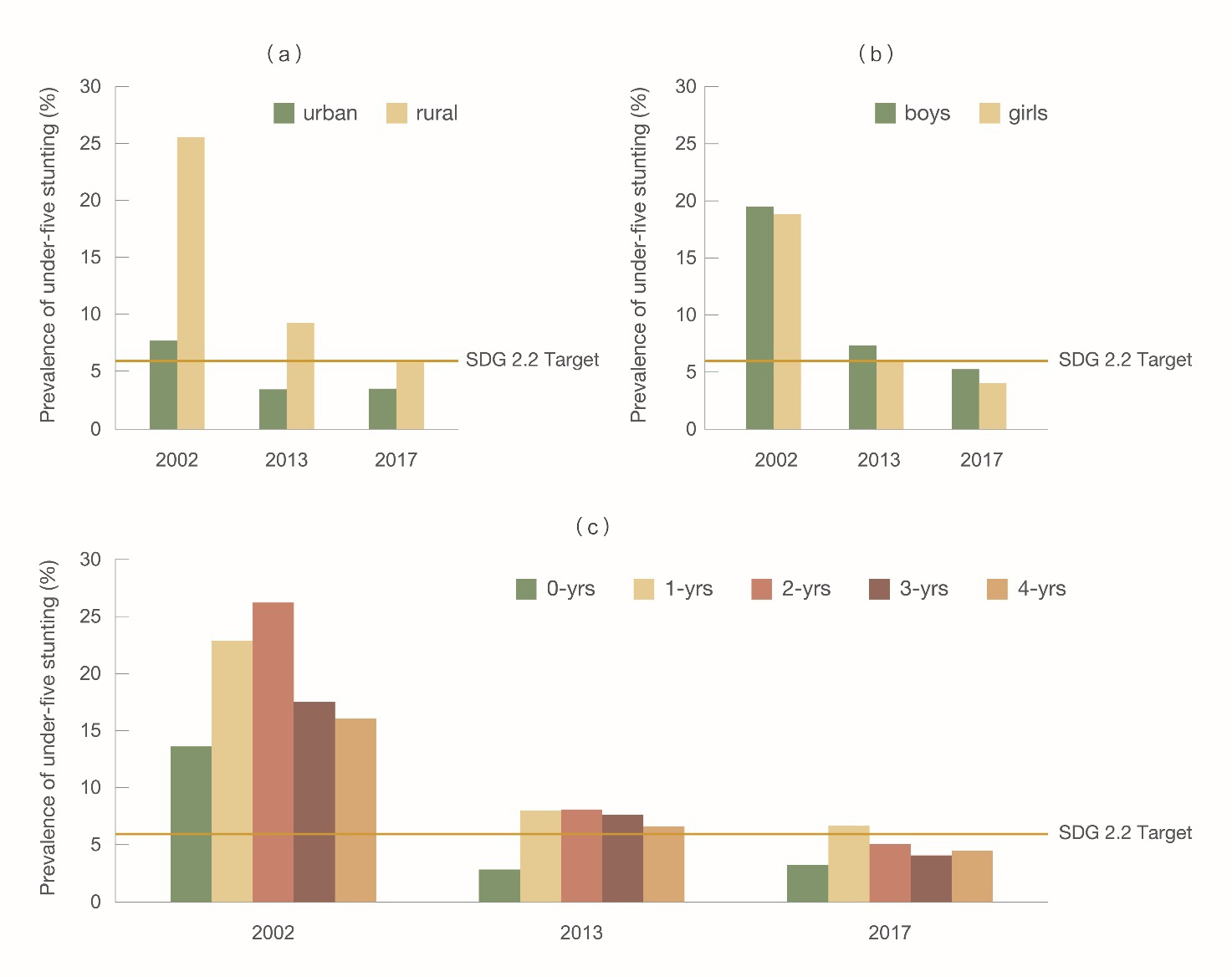SDG2: Zero Hunger
The trend of under-five stunting in China(2020)
Target: 2.2 By 2030, end all forms of malnutrition, including achieving, by 2025, the internationally agreed targets on stunting and wasting in children under 5 years of age, and address the nutritional needs of adolescent girls, pregnant and lactating women and older persons.
| Highlights |
China has substantially reduced the prevalence of stunting in children under 5 years of age from 18.8% in 2002 to 4.8% in 2017, which has met the SDG target 2.2 (under 5.9%). During the monitoring period, the prevalence of stunting among Chinese children under 5 years old decreased from 7.8% to 3.4% in urban areas and decreased from 25.6% to 5.8% in rural areas. The gap between urban and rural areas is narrowing year by year, with a significant decline observed in rural areas. |
Background
Childhood stunting is one of the most important indicators for long-term malnutrition that accounts for nearly 45% of child deaths globally (Black et al., 2013). Improving the nutritional status of children has been recognised as a key component of "Healthy China", a strategic plan for national health in China. According to the World Health Organization (WHO) Child Growth Standards, this case monitored the spatial pattern and dynamic changes of the under-five stunting rate in China from 2002 to 2017 and provided a more precise and evidence-based nutrition intervention strategy for children.
Data used
Survey data, including data from the Chinese National Nutrition and Health Survey and China Chronic Diseases and Nutrition Surveillance.
Statistical data, including data from the China Statistical Yearbook and Health Statistical Yearbook.
Method
The stunting rate was divided into five grades: <2.5% (very low), 2.5%-9.9% (low), 10.0%-19.9% (medium), 20.0%-29.9% (high), and ≥30.0% (very high) to track the trend of under-five stunting in China, with the definition of stunting as length/height for age <-2 standard deviations from the median of the WHO Child Growth Standards. Meanwhile, the results were presented by province, urban/rural area, gender (boys/girls), and age group (0-, 1-, 2-, 3-, and 4- years old), and compared with the SDG 2.2 target. Data analysis in different survey years employed data from the sixth census in 2010, with calculation of rates complexly weighted for sampling.
Results and analysis
The prevalence of under-five stunting in China decreased from 18.8% in 2002 to 4.8% in 2017, which achieved the SDG 2.2 target (5.9%). At the provincial level, only 9 provinces were identified to have a stunting rate of "low" or "very low" in 2002 (Fig. 1); by 2017, all 31 provinces were observed with a prevalence of "low" or "very low".

Figure 1. Under-five stunting in 2002 (a) and 2017 (b) by province in China

Figure 2. Trends of under-five stunting from 2002 to 2017 by urban-rural (a), gender (b), and age group (c) in China
With the continuous implementation of national children's nutrition improvement policies and programs for children under 5 years old in rural and impoverished areas, the nutritional status of children has significantly improved, while urban-rural disparities were also dramatically reduced. During the monitoring period, a significant decline in the under-five stunting rate was observed in all population subgroups, including urban, rural, gender, and age groups (Fig. 2). From 2002 to 2017, the ratio of the stunting rate of Chinese children under 5 years old between urban and rural areas decreased from 1:3.3 to 1:1.7, which achieved the SDG 2.2 target. Nevertheless, the disparities among genders and age groups still exist. The stunting rate is slightly higher in boys than girls, and higher in 1-year-old and 2-year-old groups than other age groups.
Outlook
The improvement of children's nutritional status is not only a key focus of "Zero Hunger", but also an important component for promoting and implementing the "Healthy China" strategy. At present, the global food supply system and the progress of improving children's nutritional status have been severely affected by the increasing instability of international politics and global economy, and frequent major disasters such as locust plagues, as well as the global pandemic of COVID-19. With rapid urbanization, the large-scale population flow from rural to urban areas has also brought uncertainty to children's nutritional status. Paying close attention to international political and economic impacts on the global food supply chain and focusing on children in poor rural areas and migrant children in urban areas are important approaches to ensuring a continuous reduction in the stunting rate among children in China.

